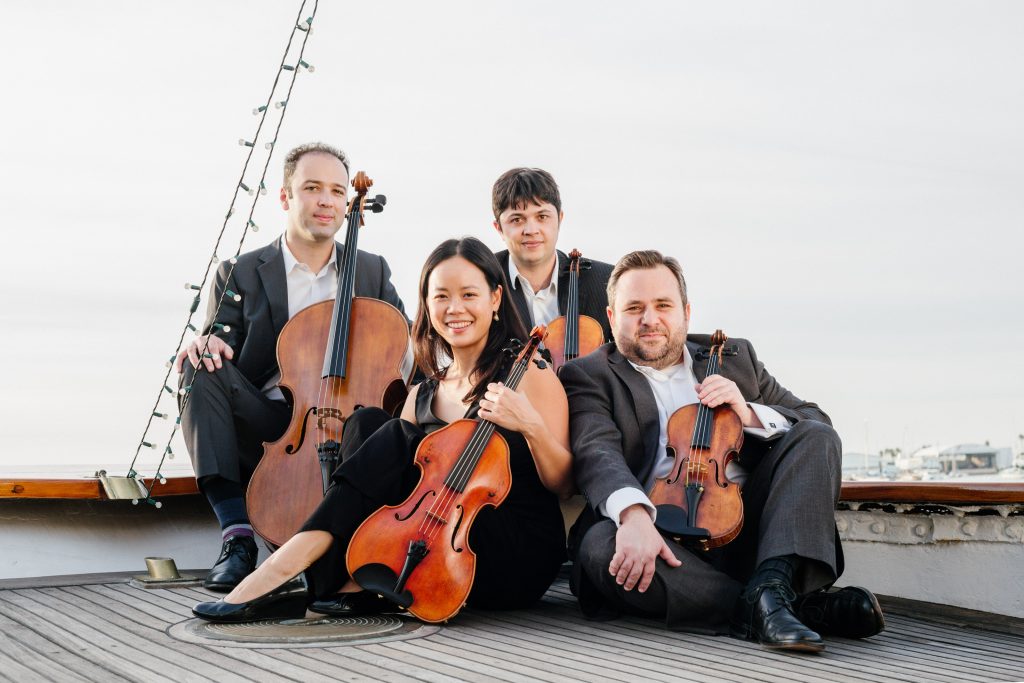Hausmann Quartet Explores the Galaxy with David Ludwig, Beethoven and Haydn
If you are puzzled to learn that the Hausmann Quartet’s Sunday program at the Maritime Museum of San Diego was planned around the outer space probes of Voyager 1 and 2, launched in 1977, you probably lack the imagination of the four clever Hausmann musicians. You see, these two spacecraft contained a gold-plated record of carefully selected music, including the Cavatina from Beethoven’s B-flat String Quartet, Op. 130, and in 1990 when Voyager was 3.7 billions miles from earth, it took a photo of our planet, which Carl Sagan christened “that pale blue dot,” because at that distance in outer space earth was no more than that.

Hausmann Quartet: (from left) Alex Greenbaum, Angela Choong, Isaac Allen, Bram Goldstein [photo (c) Samantha Zauscher]
In Ludwig’s extended, eerie etude, the vast quietude of outer space is suggested by slowly changing, slender floating timbres and hovering icy chords, the austere textures string players might conjure when asked to fill in for the Theremin player who called in sick to an orchestra concert. For contrast in Ludwig’s single movement tone poem, the composer unwraps a cute program of excited space aliens discovering the Voyager and playing its golden recording, which then allows Ludwig to quote Beethoven’s Cavatina in a skewed version played at an unusually fast tempo. Yes, machines are likely to malfunction even in outer space.
Neither the craft nor the imagination of “Pale Blue Dot” approached that of David Bruce’s stellar quartet for mixed instruments, “The Consolation of Rain,” performed last week by Art of Élan. But Ludwig did give first violinist Isaac Allen some deftly executed mesmerizing solos in his instrument’s highest range, followed by equally compelling solo lines in the cello’s upper range, eloquently supplied by Alex Greenbaum.
Coming back to earth, Hausmann launched into Haydn’s String Quartet No. 49, Op. 64/2 with unusual vigor and a pliant, buoyant sonority that more than fulfilled the composer’s second half of his opening movement title: Allegro spiritoso. Greenbaum and Allen again exchanged glowing cantabile themes in the slow movement, and each quartet player had moments of glory in the sweetly elegant Trio of the Menuet third movement. They battled against noises from the harbor in the Finale, especially the sounding of a massive cruise ship’s horn as it slowly pulled out of the adjacent berth along the edge of San Diego Bay, where the Maritime Museum’s historic Berkeley is moored and on which Hausmann gives its concerts.
Like J. S Bach’s Art of Fugue, Beethoven’s valedictory string quartet, his Opus 130, a six-movement work in B-flat major, gathers together and sums up so much of the composer’s art and musical vocabulary. Hausmann gave Opus 130 a highly respectful and spiritually generous account of this work, although I hope I am around 10 years from now to hear what these four musicians have to say about the piece then.
In the lengthy opening movement, the quartet navigated succinctly the composer’s moody, quixotic changes, giving equal care to his moments of sublime contemplation and his more playful, lighthearted episodes. I enjoyed the ensemble’s breezy, Mendelssohnian approach to the Presto, as well as the players’ contrapuntal finesse in the two middle movements. These sections allowed violist Angela Choong to flaunt her many warm, caressing themes and violinist Bram Goldstein to complement superbly Allen’s suave phrasing and articulation.
This concert was given by the Hausmann Quartet on Sunday, November 11, 2018, at the Maritime Museum of San Diego’s Berkeley ferry on San Diego Bay. The ensemble will resume its Haydn Voyages series in the same venue on January 13, 2019.

Ken Herman, a classically trained pianist and organist, has covered music for the San Diego Union, the Los Angeles Times’ San Diego Edition, and for sandiego.com. He has won numerous awards, including first place for Live Performance and Opera Reviews in the 2017, the 2018, and the 2019 Excellence in Journalism Awards competition held by the San Diego Press Club. A Chicago native, he came to San Diego to pursue a graduate degree and stayed.Read more…
